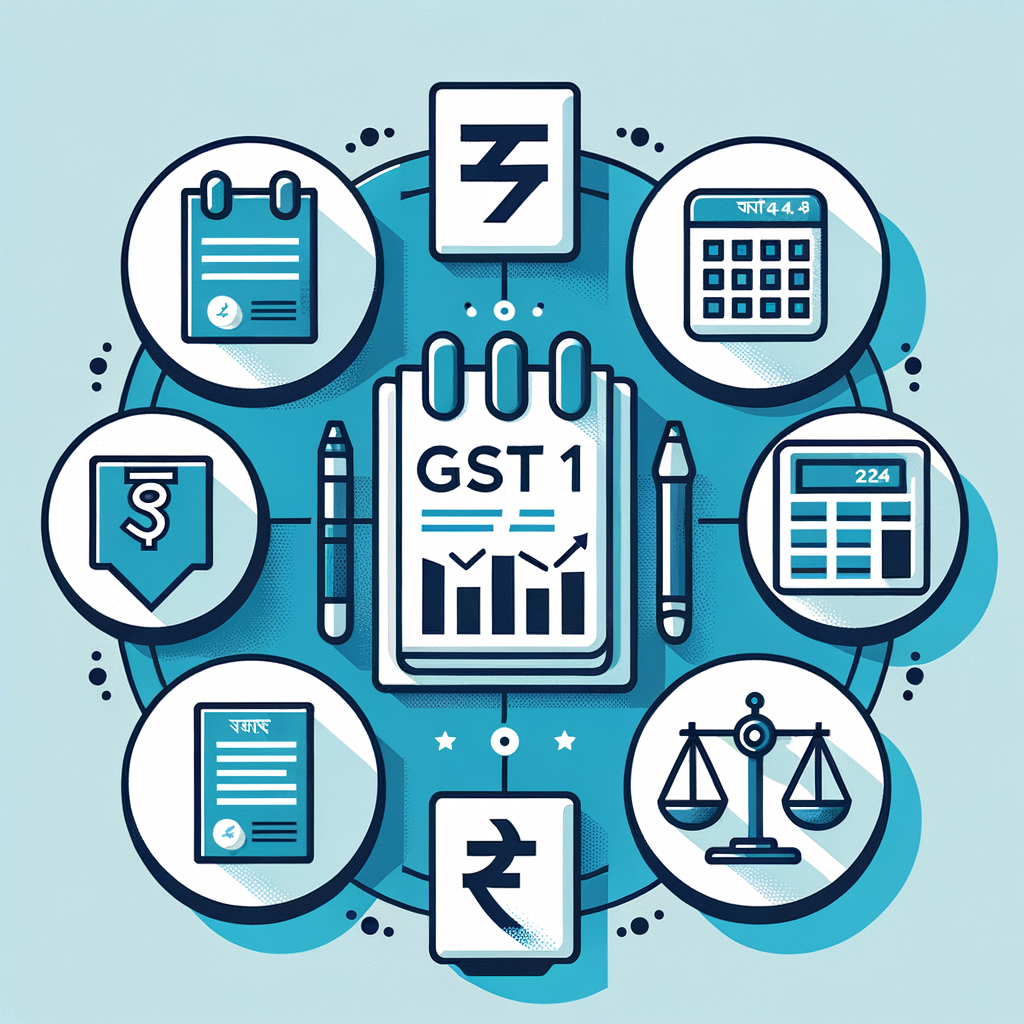GST Return Filing Calendar 2025: Due Dates for GSTR-1, 3B, 9 & 9C
As a business owner in India, juggling sales, marketing, and operations is a daily challenge. Adding the complex web of GST compliance to the mix can feel overwhelming, with different deadlines for various returns. Forgetting even one due date can lead to penalties and unnecessary stress. This is precisely why having a comprehensive GST return filing calendar 2025 is not just helpful—it’s essential for your business’s financial health. This guide is designed to be your single source of truth for all crucial GST deadlines, covering GSTR-1, GSTR-3B, GSTR-9, and GSTR-9C. By staying organized with this calendar, you can achieve peace of mind, avoid costly errors, and focus your energy on what you do best: growing your business.
Why the GST Return Filing Calendar 2025 is Crucial for Your Business
Staying on top of your GST obligations is about more than just avoiding last-minute panic. A systematic approach to filing, guided by a reliable calendar, directly impacts your bottom line, business reputation, and operational efficiency. It’s a foundational practice for any thriving enterprise in India’s tax ecosystem.
Avoiding Heavy Penalties and Late Fees
Missing a GST due date has immediate financial consequences. The government imposes penalties for both late filing and late payment of taxes.
- Late Filing Fees: A late fee is levied for each day of delay. For GSTR-1 and GSTR-3B, the standard fee is ₹50 per day (₹25 for CGST and ₹25 for SGST). For nil returns, this is reduced to ₹20 per day (₹10 for CGST and ₹10 for SGST). While these amounts are capped, they can accumulate quickly across multiple GSTINs or prolonged delays.
- Interest on Late Tax Payment: In addition to the late filing fee, if you have a tax liability that you fail to pay by the due date, you are required to pay interest at a rate of 18% per annum. This interest is calculated on the outstanding tax amount for every day of delay.
Maintaining a High GST Compliance Rating
The GST portal maintains a compliance rating for every registered taxpayer. This score is based on your timeliness in filing returns and paying taxes. A high compliance rating builds credibility and trust in the business ecosystem. Potential clients, suppliers, and lending institutions may look at this rating as an indicator of your business’s reliability and financial discipline. A poor rating, on the other hand, can act as a red flag, potentially harming business relationships and access to credit.
Ensuring Seamless Input Tax Credit (ITC) Claims
The mechanism of Input Tax Credit (ITC) is the backbone of the GST regime, preventing the cascading effect of taxes. It is crucial to understand the Section 16 of the CGST Act: Conditions and Time Limits for Availing ITC to claim it correctly. For you to claim ITC on your purchases, your supplier must have filed their GSTR-1 correctly and on time, detailing the transaction. When you are punctual with your own GSTR-1 filing, you enable your customers to claim their ITC without hassle. This seamless flow of credit throughout the supply chain is vital for healthy business operations. Delays on your part can disrupt your customers’ financial planning and strain business relationships.
Monthly & Quarterly GST Filing: GSTR-1 and GSTR-3B Deadlines 2025
GSTR-1 and GSTR-3B are the most frequent returns that businesses file, forming the basis of GST compliance. Understanding their purpose and deadlines is the first step towards mastering your tax obligations.
Understanding GSTR-1: Statement of Outward Supplies
GSTR-1 is the return where you declare the details of all your outward supplies, more commonly known as your sales. Every invoice you issue to a customer must be reported in GSTR-1. The frequency of filing GSTR-1 depends on your annual aggregate turnover and the scheme you’ve chosen.
- Monthly Filers: Taxpayers with an annual aggregate turnover of more than ₹5 crores are required to file GSTR-1 every month.
- Quarterly Filers (QRMP Scheme): Taxpayers with an aggregate turnover of up to ₹5 crores can opt for the QRMP (Quarterly Return Monthly Payment) scheme. Under this scheme, they can file their GSTR-1 once every quarter.
The GSTR-1 due dates India are critical because the data you file in your GSTR-1 automatically populates in your customers’ GSTR-2A/2B, enabling them to claim Input Tax Credit.
Understanding GSTR-3B: The Summary Return
GSTR-3B is a self-declared summary return. In this form, you report the consolidated figures of your sales, ITC claimed, and the final GST liability for the tax period. The tax due must be paid by the GSTR-3B deadline. Similar to GSTR-1, the GSTR-3B filing deadlines India depend on your turnover. However, for monthly filers, the due dates are staggered based on the state or union territory your business is registered in to ease the load on the GST portal.
GSTR-1 & GSTR-3B Due Dates Table for 2025
To simplify tracking, here is a detailed month-by-month calendar for GSTR-1 and GSTR-3B deadlines in 2025.
| Filing Period | GSTR-1 Due Date (Monthly Filers) | GSTR-1 Due Date (Quarterly Filers – QRMP) | GSTR-3B Due Date (Monthly – Group A States*) | GSTR-3B Due Date (Monthly – Group B States**) | GSTR-3B Due Date (Quarterly Filers – QRMP) |
|---|---|---|---|---|---|
| Jan 2025 | 11th Feb 2025 | – | 20th Feb 2025 | 24th Feb 2025 | – |
| Feb 2025 | 11th Mar 2025 | – | 20th Mar 2025 | 24th Mar 2025 | – |
| Mar 2025 | 11th Apr 2025 | – | 20th Apr 2025 | 24th Apr 2025 | – |
| Jan-Mar ’25 | – | 13th Apr 2025 | – | – | 22nd/24th Apr 2025 |
| Apr 2025 | 11th May 2025 | – | 20th May 2025 | 24th May 2025 | – |
| May 2025 | 11th Jun 2025 | – | 20th Jun 2025 | 24th Jun 2025 | – |
| Jun 2025 | 11th Jul 2025 | – | 20th Jul 2025 | 24th Jul 2025 | – |
| Apr-Jun ’25 | – | 13th Jul 2025 | – | – | 22nd/24th Jul 2025 |
| Jul 2025 | 11th Aug 2025 | – | 20th Aug 2025 | 24th Aug 2025 | – |
| Aug 2025 | 11th Sep 2025 | – | 20th Sep 2025 | 24th Sep 2025 | – |
| Sep 2025 | 11th Oct 2025 | – | 20th Oct 2025 | 24th Oct 2025 | – |
| Jul-Sep ’25 | – | 13th Oct 2025 | – | – | 22nd/24th Oct 2025 |
| Oct 2025 | 11th Nov 2025 | – | 20th Nov 2025 | 24th Nov 2025 | – |
| Nov 2025 | 11th Dec 2025 | – | 20th Dec 2025 | 24th Dec 2025 | – |
| Dec 2025 | 11th Jan 2026 | – | 20th Jan 2026 | 24th Jan 2026 | – |
| Oct-Dec ’25 | – | 13th Jan 2026 | – | – | 22nd/24th Jan 2026 |
Footnotes:
- Group A States: Chhattisgarh, Madhya Pradesh, Gujarat, Maharashtra, Karnataka, Goa, Kerala, Tamil Nadu, Telangana, Andhra Pradesh, Daman & Diu and Dadra & Nagar Haveli, Puducherry, Andaman and Nicobar Islands, Lakshadweep. (QRMP due date for GSTR-3B is the 22nd of the month following the quarter).
- Group B States: Himachal Pradesh, Punjab, Uttarakhand, Haryana, Rajasthan, Uttar Pradesh, Bihar, Sikkim, Arunachal Pradesh, Nagaland, Manipur, Mizoram, Tripura, Meghalaya, Assam, West Bengal, Jharkhand, Odisha, Jammu and Kashmir, Ladakh, Chandigarh, Delhi. (QRMP due date for GSTR-3B is the 24th of the month following the quarter).
Annual GST Returns: GSTR-9 and GSTR-9C Filing Schedule India for 2025
Beyond the monthly and quarterly filings, businesses must also file annual returns to provide a consolidated summary of their transactions for the entire financial year. These are GSTR-9 and GSTR-9C.
GSTR-9 (Annual Return): What You Need to Know
GSTR-9 is an annual return that must be filed once a year by taxpayers registered under GST. It is a comprehensive document that consolidates the information furnished in your monthly or quarterly returns (GSTR-1 and GSTR-3B) throughout the financial year. It provides a complete picture of your outward and inward supplies, taxes paid, and ITC claimed.
- Applicability: Filing GSTR-9 is mandatory for all taxpayers whose aggregate annual turnover exceeds ₹2 crores in a financial year. For businesses with turnover up to ₹2 crores, filing GSTR-9 is optional.
- Due Date: The GSTR-9 due date 2025 for the financial year 2024-25 (1st April 2024 to 31st March 2025) is 31st December 2025.
GSTR-9C (Reconciliation Statement): For Larger Businesses
GSTR-9C is a reconciliation statement that bridges the gap between the figures reported in the GSTR-9 annual return and the figures reported in the taxpayer’s audited annual financial statements. It ensures that the data reported under GST law is consistent with the data reported in the audited accounts.
- Applicability: GSTR-9C is mandatory for taxpayers whose aggregate annual turnover exceeds ₹5 crores in a financial year.
- Certification: This statement must be prepared and self-certified by the taxpayer. It was previously required to be certified by a Chartered Accountant (CA) or Cost Accountant (CMA), but this requirement was amended.
- Due Date: The GSTR-9C filing schedule India follows the same deadline as GSTR-9. For the financial year 2024-25, the due date for filing GSTR-9C is also 31st December 2025.
Your Complete GST Return Filing Calendar 2025 at a Glance
Keeping track of these varied deadlines can be challenging. To make it easier, we recommend you bookmark this page for quick reference. For even more convenience, we have compiled all this information into a single, easy-to-read PDF.
Download Your Free GST Calendar 2025 PDF Now!
Conclusion: Stay Ahead with TaxRobo
Adhering to the GST return filing calendar 2025 is non-negotiable for maintaining a healthy and compliant business. From the monthly deadlines for GSTR-1 and GSTR-3B to the crucial annual deadline of 31st December for GSTR-9 and GSTR-9C, each date is a critical checkpoint for your enterprise. Timely filing not only saves you from hefty penalties and interest but also enhances your business credibility and ensures a smooth flow of Input Tax Credit.
Don’t let GST deadlines stress you out. If managing these dates feels like a burden, it’s a sign to seek professional guidance. Let TaxRobo’s experts handle your GST compliance seamlessly, so you can dedicate your time to strategy and growth. Contact us today for a consultation!
Frequently Asked Questions (FAQs)
1. What is the penalty for missing a GST return filing due date?
If you miss a due date, you are liable for a late filing fee and interest on any unpaid tax. The late fee is typically ₹50 per day of delay (₹20 for nil returns), subject to a maximum cap. Additionally, interest at 18% per annum is charged on the outstanding tax liability from the due date until the date of payment.
2. What is the QRMP scheme mentioned in the calendar?
The Quarterly Return Monthly Payment (QRMP) scheme is an option for small taxpayers with an aggregate annual turnover of up to ₹5 crores. It allows them to file their GSTR-1 and GSTR-3B returns on a quarterly basis, while requiring them to pay their tax dues monthly. This scheme is designed to reduce the compliance burden on small and medium-sized businesses, similar to the option of Understanding the Composition Scheme Under GST.
3. Is filing GSTR-9 (Annual Return) mandatory for all businesses?
No, it is not mandatory for everyone. As per current rules, filing GSTR-9 is mandatory only for taxpayers whose aggregate annual turnover is more than ₹2 crores during the financial year. For businesses with a turnover of up to ₹2 crores, filing the annual return is optional, though it is often recommended as a good practice to ensure all data for the year is reconciled.
4. Can I file my GST returns without professional help?
Yes, taxpayers can file their returns directly through the official GST Portal, and our guide on How to File GST Returns Online: A Step-by-Step Guide of the GST Filing Process & Procedure can help. The portal is designed for self-service. However, the process can be complex, and errors can lead to notices or penalties. Engaging a professional like TaxRobo offers several benefits, including accuracy, time-saving, ensuring correct ITC claims, and providing strategic advice on GST matters, ultimately saving you money and hassle in the long run.



